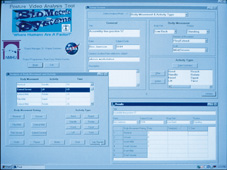Sit Up Straight
Laying down on the job is every astronaut's starting position en route to space.
Reclining crew members are on their backs for several hours awaiting launch. Bad posture or protracted activities during work, even for a space traveler, can cause strain and fatigue.
One would think if a person's work was confined to the microgravity of space, such a free-floating experience would cause little worry. But astronauts in training for the Space Shuttle and space station programs receive the do's and don'ts of correctly positioning their bodies.
A posture video analysis tool (PVAT) was developed at the Johnson Space Center (JSC). The video uses scenes from Space Shuttle flights to classify limiting posture and other human factors in the workplace. NASA needed a low-cost, reliable method of collecting data on astronaut postures from non-scientific mission video. The traditional "paper and pencil" video analysis methods are very subjective. The current state-of-the-art digitizing system requires a predefined view from spacecraft cameras as well as specific reference points to classify working posture.
With the new video tool, researchers use regular non-scientific shuttle videos to gather precise information about astronaut working postures and movements. The software side of PVAT provides data that ranks postures for certain tasks and duration of time in a position.
Button-driven software and an interactive menu collect information on a variety of postural parameters--body orientation, body part movement, severe or mild flexation rating, and task description. Once all the entries are made, analysis begins with the touch of a button. The tool also includes a terminology library. Selected posture classifications are illustrated in animated form. Data reduction summaries and report capabilities are incorporated to round out the video software product.
BioMetric Systems of Houston, Texas, has received an exclusive license from JSC to further develop PVAT for use by non-aerospace industries, such as hospitals, physical rehabilitation facilities, insurance companies, sports medicine clinics, oil companies, manufacturers and the military. BioMetric learned of the software from the Mid-Continent Technology Transfer Center (MCTTC), one of NASA's Regional Technology Transfer Centers.
When used with videotape, the PVAT system allows BioMetric to perform ergonomic analyses of people in the workplace. Examples of how the system can be used include gathering information to determine the correct height of a keyboard or the proper height of a chair or stool. The system also will help a company determine if employee ailments are caused by inefficient equipment setup or poor worker technique.
"PVAT is unique because it provides a fast and simple way to collect and classify working postures, even from videos not recorded specifically for experimental analysis," says BioMetric Systems President, Candace Caminati. "We are excited about PVAT's human factors design and analysis potential in a variety of commercial industries," Caminati says.
The human factors engineering company is augmenting the JSC PVAT software systems for use on different types of computer operating systems. Assistance in this upgrade was provided by JSC's Technology Transfer and Commercialization Office.
After obtaining the exclusive license from NASA, the company embarked on a technology research improvement program with New Mexico Highlands University. As part of BioMetric's product development program, the company submitted a formal proposal to NASA's Small Business Technology Transfer (STTR) program for cooperative research and development with a research institution.
BioMetric Systems has grown into a respected manufacturer and distributor of computer software for scientific and engineering analysis of human factors relating to medical, petrochemical and space operations/simulations applications. The company provides training, workshops, and consulting on ergonomic design, soft tissue injuries, sports medicine, athletics, personal injury, workman's compensation, exercise physiology, stress analysis, and return-to-work programs.
As a woman-owned small business, BioMetric was the first Native American company to license commercial technology with JSC.
BioMetric has settled on three versions of the PVAT software service package. One version provides instructions for clients to setup, use, and analyze ergonomic data themselves; another lets clients use the package and return the results to BioMetric for analysis; and a third version is designed to have BioMetric perform the work onsite, from setup to analysis.

The PVAT system helps companies perform ergonomic analyses of employees in the workplace. This screen shows extensive activity type and body movement criteria that can be applied to the subject being evaluated. The system is based on a video analysis tool for collecting data astronaut postures.













